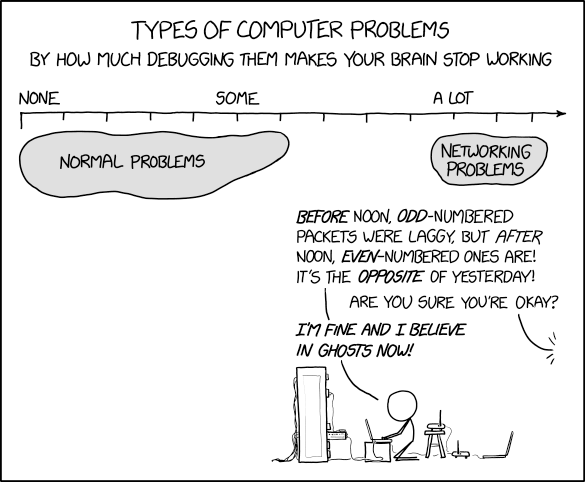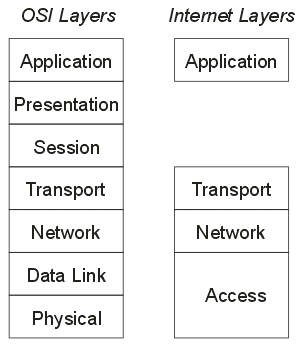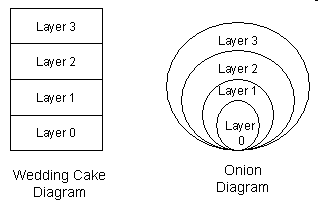A Layered View of Communications Networks
An Introduction
|
|
Prof. David Bernstein
James Madison University
|
|
| Computer Science Department |
| bernstdh@jmu.edu |

|
Motivation
- An Observation:
- Networks can be and are considered at different levels of
abstraction/resolution
- A Problem that Arises:
- This makes it hard for multiple parties to develop components
that interact correctly
- Overcoming this Problem:
- Create a unified view of all networks so that
components can interact with each other as needed
Layered Architectures
- The Concept:
- Functional components are arranged in groups that provide a
layer of services
- Each layer hides all (strict) or most
(relaxed or transparent) of the
layers below
- A Good and Bad Visualization:
Advantages and Disadvantages of Layered Architectures
- Advantages:
- Standards can be developed for each layer independently
- One protocol can be substituted for another (at the same layer)
without affecting any other layers
- Disadvantages:
Advantages and Disadvantages (cont.)
Nerd Humor - Networking Problems

(Courtesy of xkcd)
The Open Systems Interconnection (OSI) Layers
- When?
- Who?
- The International Standards Organization (ISO)
- Why?
- Create standards that would promote multi-vendor interoperability
The Open Systems Interconnection (OSI) Layers (cont.)
- Layer 7 - Application:
- Involves user requests
- Sometimes said to provide semantics
- Layer 6 - Presentation:
- Adds formatting/display information in an application/machine
independent way (e.g., ASCII/EBCDIC/Unicode,
big-endian/little-endian)
- Layer 5 - Session:
- Provides session control (a.k.a. dialog coordination)
- Layer 4 - Transport:
- Provides process-to-process data transfer
- Layer 3 - Network:
- Provides host-to-host data transfer that is independent of
the switching mechanism (a.k.a. routing/relaying)
- Layer 2 - Data Link:
- Provides blocking/framing, synchronization, error control,
and flow control on direct links
- Layer 1 - Physical:
- Provides transmission of unstructured bit streams
over the physical medium
The IEEE Layers
- Similarities to OSI:
- The highest six layers are the same
- Differences from OSI:
- The data link and phsyical layers are changed to
the logical link control, media access control
and physical layers
The Internet: A 5-Layer View
- Layer 5 - Application:
- Includes Hypertext Transfer Protocol (HTTP) and File Transfer Protocol (FTP)
- Layer 4 - Transport:
- Includes Transmission Control Protocol (TCP) and User Datagram Protocol (UDP)
- Layer 3 - Network:
- Includes Internet Protocol (IP)
- Layer 2 - Link:
- Includes Point-to-Point Protocol (PPP) and Ethernet
- Layer 1 - Physical:
- Includes the different protocols for Ethernet on different
physical media
The Internet: A 5-Layer View (cont.)
- Be Careful:
- Sometimes Layers 1 and 2 are combined to create a four-layer view
(with the lowest level called the Access layer)
- The Data at Each Layer:
- The complete "message" at layer \(i\) is the payload
at layer i-1 (e.g., an HTTP "message" which has its own
header and payload becomes the payload for a TCP "message" which
has its own header, which becomes the payload for an IP
"message" that has its own header)
- Terminology at Each Layer:
- At each layer, the terminology changes (frame at layers 1/2,
datagram at layer 3, segment at layer 4, message at layer 5)
OSI Layers and the Internet
One Interpretation

Layers in Asynchronous Transfer Mode (ATM)
- ATM Adaptation Layer:
- Convergence (CS) -- standard interface
- Segmentation and Reassembly (SAR) - between cells and packets
- ATM Layer:
- Flow control, virtual circuit/path management, cell
multiplexing/demultiplexing
- Physical Layer:
- Transmission Convergence (TC) -- checksum generation/checking,
cell generation
- Physical Medium Dependent (PMD) -- bit timing, physical network
access


